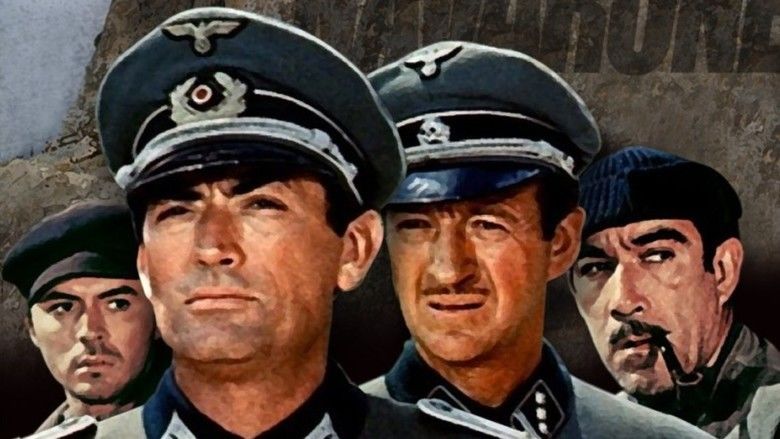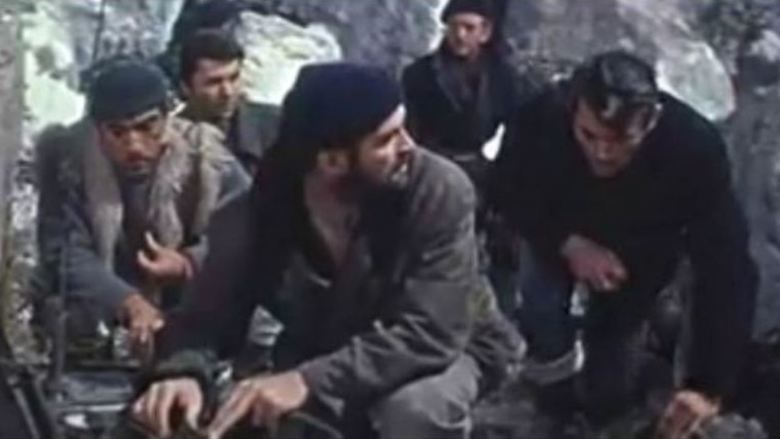The Guns of Navarone (film)
8.6 /10 1 Votes
95% Rotten Tomatoes Genre Action, Adventure, Drama Country United KingdomUnited States | 7.6/10 IMDb Director J. Lee Thompson Duration Language English | |||||||||||||||||||||||||||||||||
 | ||||||||||||||||||||||||||||||||||
Release date 27 April 1961 (Royal World Premiere, London)22 June 1961 (1961-06-22) Film series The Guns of Navarone Film Series Cast (Capt. Keith Mallory), (Cpl. Miller), (Col. Andrea Stavros), (Pvt. 'Butcher' Brown), (Maj. Roy Franklin), (Pvt. Spyros Pappadimos) Similar movies The Thin Red Line , Fury , Saving Private Ryan , Avatar , Blackhat , The Lord of the Rings: The Two Towers Tagline The Greatest High Adventure Ever Filmed! | ||||||||||||||||||||||||||||||||||
The guns of navarone 1961 original trailer
The Guns of Navarone is a 1961 British-American epic adventure war film directed by J. Lee Thompson. The screenplay by producer Carl Foreman was based on Alistair MacLean's 1957 novel The Guns of Navarone, which was inspired by the Battle of Leros during the Dodecanese Campaign of World War II. The film stars Gregory Peck, David Niven and Anthony Quinn, along with Stanley Baker, Irene Papas, Gia Scala, James Darren and Anthony Quayle. The book and the film share the same basic plot: the efforts of an Allied commando unit to destroy a seemingly impregnable German fortress that threatens Allied naval ships in the Aegean Sea.
Contents
- The guns of navarone 1961 original trailer
- The guns of navarone scene
- Plot
- Historical background
- Production
- Reception
- Awards and honors
- Sequel
- In popular culture
- References

The guns of navarone scene
Plot

In 1943, the Axis powers plan an assault on the island of Kheros — where 2,000 British soldiers are marooned — to display their military strength and convince neutral Turkey into joining them. Rescue by the Royal Navy is prevented by two massive radar-directed superguns on the (fictional) nearby island of Navarone. When aerial bombing efforts fail, Allied Intelligence gathers a commando unit to infiltrate Navarone and destroy the guns. Led by Major Roy Franklin (Anthony Quayle), the team is composed of Captain Keith Mallory (Gregory Peck), a renowned spy; Colonel Andrea Stavrou (Anthony Quinn) from the defeated Greek army; Franklin's best friend Corporal Miller (David Niven), an explosives expert and former chemistry teacher; Greco-American Spyros Pappadimos (James Darren), a native of Navarone; and "Butcher" Brown (Stanley Baker), an engineer and expert knife fighter.

Disguised as Greek fishermen on a decrepit fishing vessel, they sail across the Aegean Sea, where they successfully overwhelm the crew of a German patrol boat intercepting them. Later in the voyage, Mallory confides to Franklin that Stavrou had sworn to kill him after the war, because Mallory was inadvertently responsible for the deaths of Stavrou's wife and children. After shipwrecking on Navarone's coast during a storm, the experienced mountaineer Mallory leads the team in a climb up the cliff. Franklin badly injures his leg while climbing. While taking shelter in the mountains, Mallory stops Franklin from committing suicide and lies to him that their mission is only a diversion and a major naval attack will be mounted on the coast instead. They rendezvous with two local resistance fighters, Spyros' sister Maria (Irene Papas) and her friend Anna (Gia Scala), who was once captured and tortured by the Germans before escaping.

The mission is continually dogged by German soldiers and the group is eventually captured in the town of Mandrakos by Oberleutnant Meusel (Walter Gotell) while trying to find a doctor for Franklin (whose leg is infected with gangrene). While being interrogated by SS Hauptsturmführer Sessler (George Mikell), Stavrou distracts the Germans and the team overpowers their captors. They escape in German uniforms, leaving Franklin behind to receive medical attention. In due course, Franklin is injected with scopolamine and gives up Mallory's misinformation. As Mallory had hoped, most forces leave the fortress to counter the expected coastal attack. Upon infiltrating the village of Navarone, however, Miller discovers most of his explosives have been sabotaged and deduces that Anna is the culprit. She confesses that the Germans recruited her as an informer in exchange for her release. Mallory reluctantly prepares to execute Anna as a precaution against detection, but Maria shoots her instead.

The team splits up: Mallory and Miller go for the guns, Stavrou and Spyros create distractions in town, assisted by local residents, and Maria and Brown steal a boat for their escape. Spyros dies in a stand-off with a German officer, and Brown from being stabbed during the boat theft. Meanwhile, Mallory and Miller infiltrate the gun emplacement, but set off an alarm when they seal the doors behind them. Miller plants explosives on the guns and prepares a large booby trap below an ammunition hoist, with a trigger device set into the hoist's track. The Germans eventually gain entry into the gun emplacement and defuse the explosives planted directly on the guns; meanwhile, Mallory and Miller make their escape over the cliff, reaching the stolen boat. A wounded Stavrou is also able to reach the sea and is helped aboard by Mallory, thus resolving the blood feud between them.
As the Allied destroyers trying to rescue the trapped British troops appear, the Germans begin to fire—and begin hoisting in more ammunition. When the hoist reaches Miller's trigger, the hidden explosives set off the surrounding shells in a huge explosion that destroys the guns and the entire fortress. Mallory's team safely reaches the British convoy, but Stavrou decides to return to Navarone with Maria, with whom he has fallen in love. Mallory and Miller, returning home, observe the aftermath of their success from a destroyer.
Historical background
1943 was a turning point in World War II. The German advances on the Eastern Front had stalled and by February 1943, the German Army had taken tremendous losses, especially at Stalingrad. Italy's war efforts had exhausted its forces and the initiative in the Mediterranean area had fallen almost entirely to the Germans. The North African Campaign was lost for the Axis powers (Second Battle of El Alamein in October 1942, Anglo-American landings in November 1942, final surrender of the German Afrika Korps in May 1943). At the Casablanca Conference in early 1943, the British argued for further operations in the Balkans to bring Turkey into the war on the allied side, but in May 1943, the Americans extracted a British commitment to focus Allied operations in the Mediterranean to an invasion of the Italian mainland, starting with the successful Allied invasion of Sicily in July to August 1943. The following Allied invasion of Italy started on 3 September 1943 and ended with the surrender of Italy in the same month.
The British forces attempted to seize this opportunity by taking control of the Italian-held Dodecanese island group in the southeastern Aegean Sea, close to Turkey. Strategically important islands were Rhodes with airport facilities and Leros with an excellent deep-water port at Lakki (Portolago). However, the Allied Dodecanese campaign, lasting from 8 September to 22 November 1943, was a failure, with all islands falling to the German army. The Allies suffered heavy losses in men and ships, largely as a result of German air superiority. The Dodecanese campaign resulted in one of the last big German victories in the war. Turkey historically had been an ally of Germany in World War I but remained neutral through most of WW II (entering on the side of the Allies on 23 February 1945).
The situation in Kheros is modeled on the Battle of Leros where 3,200 British and 5,350 Italians were taken prisoner by the Germans. The guns and the evacuation flotilla are fictional, however. Also, fully radar-controlled guns were available only to the British and US Navy; the Axis powers lacked this capability.
Production
The film was part of a cycle of big-budget World War II adventures that included The Bridge on the River Kwai (1957), The Longest Day (1962) and The Great Escape (1963). The screenplay, adapted by producer Carl Foreman, made significant changes from the novel The Guns of Navarone by Alistair MacLean. The film was directed by J. Lee Thompson. Thompson was brought in after original director Alexander Mackendrick was fired by Carl Foreman a week before shooting started due to "creative differences".
The Greek island of Rhodes provided locations and Quinn was so taken with the area that he bought land there in an area still called Anthony Quinn Bay. Some further scenes were shot on the islands of Gozo, near Malta, and Tino, in the Ligurian Sea. One of the warships in the film, the USS Slater, then a training ship in the Hellenic Navy known as Aetos (D-01), is preserved as a museum ship in Albany, New York.
As described by director Thompson in the DVD commentary track, David Niven became severely ill after shooting in the pool of water underneath the cave elevator and almost died, remaining in hospital for some weeks as other portions of the cave sequence were completed by the crew. However, since key scenes with Niven remained incomplete at that time, and it was doubtful whether Niven would be able to return to finish the film, the entire production was in jeopardy. Reshooting key scenes throughout the film with some other actor—and even abandoning the whole project to collect the insurance—was contemplated. Fortunately, Niven was able to complete his scenes some weeks later.
A complication arose when it was found that Gregory Peck, whose character was supposed to be fluent in German, could not speak the language convincingly. Voice actor Robert Rietty dubbed all of Peck's German dialogue for the film.
The film's maps were created by Halas and Batchelor, a British team best known for their animated films.
Several members of the Greek royal family visited the set the day the Mandrakos cafe scene was filmed and appear in the background as extras.
Reception
The Guns of Navarone had its Royal World Premiere in aid of the Edwina Mountbatten Trust and in the presence of Her Majesty Queen Elizabeth II and His Royal Highness The Duke of Edinburgh on April 27, 1961, at the Odeon Leicester Square in London's West End. The film grossed $28,900,000 at the box office and was the second top-grossing film of 1961, earning a net profit of $18,500,000.
Awards and honors
Won
Nominated
Sequel
In 1968, author Alistair MacLean reunited Mallory, Miller, and Stavros in the best-selling novel Force 10 From Navarone, the only sequel of his long writing career. That was in turn filmed as the significantly different Force 10 from Navarone in 1978 by British director Guy Hamilton, a veteran of several James Bond films. The cast included Robert Shaw, Harrison Ford and Edward Fox. Though the sequel was a modest success, it did not match the original critically or commercially.
In popular culture
References
The Guns of Navarone (film) WikipediaThe Guns of Navarone (film) IMDbThe Guns of Navarone (film) Rotten TomatoesThe Guns of Navarone (film) themoviedb.org
